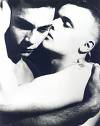Part of Winter 1990
D. Jarman, 70 min, 1985.
TG Psychic Rally in Heaven
D. Jarman, 8 min, 1980
The Angelic Conversation is a meditation on passages from Shakespeare’s sonnets. It is a meditation on light, cinema, desire, death. The writer’s beloved shines in the reflection of his gaze. Cinema reflects the gaze, doubling as light, reflected off the water and body of a young man as he bathes, paralleling the projector beam as another youth, holding a mirror, reflects the sun into the camera.
“As in Warhol’s cinema, the camera and we the audience have these faces, these bodies, presented in a slower time than that of viewing. Slow motion increases the sense of mastery over the image. These young men are now literally caught in our gaze. Yet being just film images they escape, already part of the past.
“In the Sonnets, the writer tries to wrest his beloved from the processes of time and ageing:…but you shall shine more bright in these contents than un- swept stone, besmear’d with sluttish time…’gainst death and all-oblivious enmity shall you pace forth…you live in this, and dwell in lovers’ eyes. The Angelic Conversation foregrounds the simultaneous presence and absence inherent in the cinematic image. The occasional passage of real-time video footage serves to reinforce this.” (Mark Nash, Innocence and Experience)
Jarman has described The Angelic Conversation as one of his personal, poetic works. Slow speed super-8 transposed through video to 35mm produces the crudely hypnotic effect that pervades much of the film. The technique follows from the extensive use Jarman has made of super-8’s traditional rough-hewn vocabulary as a metaphor for an erotic private space. The grainy streaked colour effect is like a strong broad brush-stroke, and assisted by the degeneration effect of re-filming the colours are often softened and suffused. The rhythm is one which Jarman describes aptly, as like a ‘heart-beat’–sensual, dream-like and erotic. The slowing down of film, the freeing of a shot is a means of eroticizing not only people and their gestures but also objects themselves. “The most mundane action, the turn of a head, movement of the lips in speech, natural blinking, take on an ‘otherness’, transforming the everyday into an almost heroic and highly-wrought expressiveness.” (Michael O’Pray, Afterimage)
TG Psychic Rally in Heaven documents the early heyday of industrial music in the figure of its bad boy-king Genesis P. Orridge and his band Throbbing Gristle. The film is an example of Jarman’s shorter, lower budget work which has rarely been shown outside of Britain.


